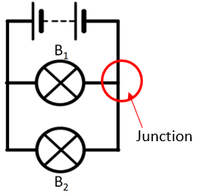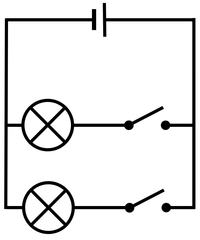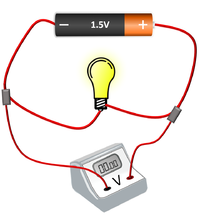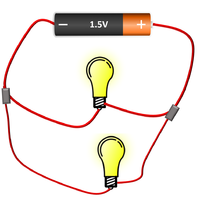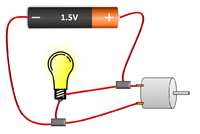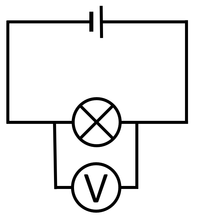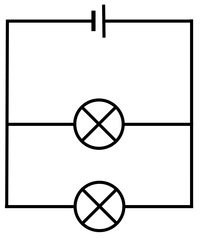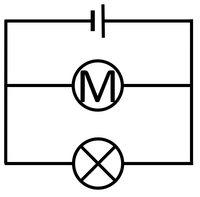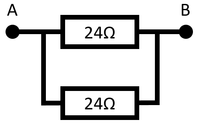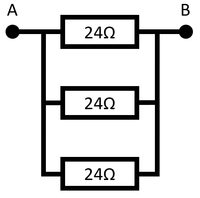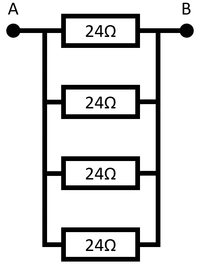Difference between revisions of "Parallel Circuit"
| Line 15: | Line 15: | ||
| style="height:20px; width:200px; text-align:center;" |The two [[Electrical Bulb|bulbs]] in this '''parallel circuit''' can be switched on and off separately. | | style="height:20px; width:200px; text-align:center;" |The two [[Electrical Bulb|bulbs]] in this '''parallel circuit''' can be switched on and off separately. | ||
|} | |} | ||
| − | |||
| − | |||
===Examples=== | ===Examples=== | ||
| Line 29: | Line 27: | ||
|[[File:CircuitDiagramCellMotorBulbParallel.png|center|200px]] | |[[File:CircuitDiagramCellMotorBulbParallel.png|center|200px]] | ||
|- | |- | ||
| − | | style="height:20px; width:200px; text-align:center;" |The [[Electrical Cell|cell]], [[Electrical Bulb|bulb]] and [[ | + | | style="height:20px; width:200px; text-align:center;" |The [[Electrical Cell|cell]], [[Electrical Bulb|bulb]] and [[voltmeter]] are in [[Parallel Circuit|parallel]] so they have the same [[Potential Difference|potential difference]] across them. |
| − | | style="height:20px; width:200px; text-align:center;" |The two [[Electrical Bulb|bulbs]] are in [[Parallel Circuit|parallel]] so they have the same [[Potential Difference]] across them but may have a different [[Electrical Current|Current]] passing through them. | + | | style="height:20px; width:200px; text-align:center;" |The two [[Electrical Bulb|bulbs]] are in [[Parallel Circuit|parallel]] so they have the same [[Potential Difference|potential difference]] across them but may have a different [[Electrical Current|current]] passing through them. |
| − | | style="height:20px; width:200px; text-align:center;" |The [[Electrical Bulb|bulb]] and [[motor]] are in [[Parallel Circuit|parallel]] so they have the same [[Potential Difference]] across them but may have a different [[Electrical Current| | + | | style="height:20px; width:200px; text-align:center;" |The [[Electrical Bulb|bulb]] and [[motor]] are in [[Parallel Circuit|parallel]] so they have the same [[Potential Difference|potential difference]] across them but may have a different [[Electrical Current|current]] passing through them. |
| + | |} | ||
| + | |||
| + | ==Key Stage 4== | ||
| + | ===Meaning=== | ||
| + | A [[Parallel Circuit]] is an [[Circuit|electrical circuit]] with two or more paths the [[Electrical Current|current]] can flow along. | ||
| + | |||
| + | ===About Parallel Circuits=== | ||
| + | : In a '''parallel circuit''' the [[Electrical Current|current]] is split at junctions before taking a different path. | ||
| + | : [[Switch|Switches]] can be placed in a [[Parallel Circuit|parallel circuit]] to allow [[Electrical Current|current]] along one path at a time. | ||
| + | : [[Electrical Component|Components]] placed in '''parallel''' with each other have the same [[Potential Difference|potential difference]] across them. | ||
| + | {| class="wikitable" | ||
| + | |- | ||
| + | |[[File:CircuitDiagramBatteryBulbBulbParallel.png|center|200px]] | ||
| + | |[[File:CircuitDiagramBulbSwitchBulbSwitchParallel.png|center|200px]] | ||
| + | |- | ||
| + | | style="height:20px; width:200px; text-align:center;" |The [[Electrical Current|current]] from the [[battery]] splits at the [[junction]] sharing the [[Electrical Current|current]] between the two [[Electrical Bulb|bulbs]]. | ||
| + | | style="height:20px; width:200px; text-align:center;" |The two [[Electrical Bulb|bulbs]] in this '''parallel circuit''' can be switched on and off separately. | ||
| + | |} | ||
| + | |||
| + | ===Examples=== | ||
| + | {| class="wikitable" | ||
| + | |[[File:CircuitDiagramCellBulbVoltmeterParallel.png|center|200px]] | ||
| + | |[[File:CircuitDiagramCellBulbBulbParallel.png|center|200px]] | ||
| + | |[[File:CircuitDiagramCellMotorBulbParallel.png|center|200px]] | ||
| + | |- | ||
| + | | style="height:20px; width:200px; text-align:center;" |The [[Electrical Cell|cell]], [[Electrical Bulb|bulb]] and [[voltmeter]] are in [[Parallel Circuit|parallel]] so they have the same [[Potential Difference|potential difference]] across them. | ||
| + | | style="height:20px; width:200px; text-align:center;" |The two [[Electrical Bulb|bulbs]] are in [[Parallel Circuit|parallel]] so they have the same [[Potential Difference|potential difference]] across them but may have a different [[Electrical Current|current]] passing through them. | ||
| + | | style="height:20px; width:200px; text-align:center;" |The [[Electrical Bulb|bulb]] and [[motor]] are in [[Parallel Circuit|parallel]] so they have the same [[Potential Difference|potential difference]] across them but may have a different [[Electrical Current|current]] passing through them. | ||
| + | |} | ||
| + | |||
| + | ===Resistors in Parallel=== | ||
| + | ''NB: You only need to know what happens with identical [[resistor]]s in [[Parallel Circuit|parallel]].'' | ||
| + | |||
| + | : When identical [[resistor]]s are added in [[Parallel Circuit|parallel]] there are more paths for the [[electricity]] so the [[Electrical Resistance|resistance]] is reduced. | ||
| + | |||
| + | {| class="wikitable" | ||
| + | |- | ||
| + | |[[File:ResistorsParallel2.png|center|200px]] | ||
| + | |[[File:ResistorsParallel3.png|center|200px]] | ||
| + | |[[File:ResistorsParallel4.png|center|200px]] | ||
| + | |||
| + | |- | ||
| + | | style="height:20px; width:200px; text-align:center;" |Two identical [[resistor]]s in [[Parallel|Parallel circuit]] gives twice the number of paths, so has half the [[Electrical Resistance|resistance]]. | ||
| + | |||
| + | The [[Electrical Resistance|resistance]] between points A and B is 12Ω. | ||
| + | | style="height:20px; width:200px; text-align:center;" |Three identical [[resistor]]s in [[Parallel|Parallel circuit]] gives three times the number of paths, so has a third of the [[Electrical Resistance|resistance]]. | ||
| + | |||
| + | The [[Electrical Resistance|resistance]] between points A and B is 8Ω. | ||
| + | | style="height:20px; width:200px; text-align:center;" |Four identical [[resistor]]s in [[Parallel|Parallel circuit]] gives four times the number of paths, so has a quarter of the [[Electrical Resistance|resistance]]. | ||
| + | |||
| + | The [[Electrical Resistance|resistance]] between points A and B is 6Ω. | ||
|} | |} | ||
Revision as of 18:44, 28 February 2019
Contents
Key Stage 3
Meaning
A Parallel Circuit is an electrical circuit with two or more paths the current can flow along.
About Parallel Circuits
- In a parallel circuit the current is split at junctions before taking a different path.
- Switches can be placed in a Parallel Circuit to allow current along one path at a time.
- Components placed in parallel with each other have the same Potential Difference across them.
| The current from the battery splits at the junction sharing the current between the two bulbs. | The two bulbs in this parallel circuit can be switched on and off separately. |
Examples
| The cell, bulb and voltmeter are in parallel so they have the same potential difference across them. | The two bulbs are in parallel so they have the same potential difference across them but may have a different current passing through them. | The bulb and motor are in parallel so they have the same potential difference across them but may have a different current passing through them. |
Key Stage 4
Meaning
A Parallel Circuit is an electrical circuit with two or more paths the current can flow along.
About Parallel Circuits
- In a parallel circuit the current is split at junctions before taking a different path.
- Switches can be placed in a parallel circuit to allow current along one path at a time.
- Components placed in parallel with each other have the same potential difference across them.
| The current from the battery splits at the junction sharing the current between the two bulbs. | The two bulbs in this parallel circuit can be switched on and off separately. |
Examples
| The cell, bulb and voltmeter are in parallel so they have the same potential difference across them. | The two bulbs are in parallel so they have the same potential difference across them but may have a different current passing through them. | The bulb and motor are in parallel so they have the same potential difference across them but may have a different current passing through them. |
Resistors in Parallel
NB: You only need to know what happens with identical resistors in parallel.
- When identical resistors are added in parallel there are more paths for the electricity so the resistance is reduced.
| Two identical resistors in Parallel circuit gives twice the number of paths, so has half the resistance.
The resistance between points A and B is 12Ω. |
Three identical resistors in Parallel circuit gives three times the number of paths, so has a third of the resistance.
The resistance between points A and B is 8Ω. |
Four identical resistors in Parallel circuit gives four times the number of paths, so has a quarter of the resistance.
The resistance between points A and B is 6Ω. |
